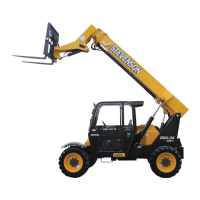913323/CP0112 36 PRINTED IN U.S.A.
WARNING
Excessive speed can be hazardous. ALWAYS
exercise caution and good judgement while
operating the machine.
ALWAYS maintain a safe distance from elec-
tric power lines and avoid contact with any
electrically charged conductor and gas line. It
is not necessary to make direct contact with a
power line for power to ground through the
structure of the machine. Keep the boom and
load at least 10 ft. (3 m) from all power lines.
Accidental contact with a power line or rup-
ture of a gas line can result in electrocution or
an explosion. Contact the “Call Before You
Load Capacity and Reach
The machine has flip-charts in the operator’s station
that provide, at a glance, the load capacity limits at var-
ious positions of attachment tool extension and eleva-
tion. A set of the load zone charts is reproduced at the
end of this manual for reference.
A typical load zone chart is shown on the next page.
The scale on the left indicates height in feet above the
ground level. The scale on the bottom shows the dis-
tance in feet from the front of the machine. The arc
lines noted by the numbers “1” through “5” correspond
with the position extension markers on the operator
side of the intermediate boom section.
The following example illustrates proper use of the
load zone charts for the Telescopic Handler:
Controlled lighting of adequate intensity should be
provided in operating areas. Where operating condi-
tions dictate, the operator/user is responsible for hav-
ing the machine equipped with lights.
Provisions should be made to prevent trucks, semi-
trailers and railroad cars from being moved during
loading and unloading. Wheel stops, parking brakes, or
other positive holding means should be used to prevent
movement during loading and unloading.
DO NOT move railroad cars and trailers with the
Telescopic Handler.
DO NOT use the boom and attachment for leverage to
push the machine out of mud.
IMPORTANT: DO NOT lower boom at high
engine speed when attachment tool is at maxi-
mum rearward tilt. Damage to slave cylinders may
result.
GENERAL LOAD HANDLING
NEVER operate controls except from the operator’s
seat. NEVER jerk or use fast movements. Avoid sud-
den stops, starts and changes in direction.
Operation of the hydraulic system depends on engine
speed and the distance the controls are moved. When
operating these controls it is important to develop a
technique called “feathering.” Feathering the control
means starting the desired motion by moving the con-
trol a small distance away from neutral. Then, after
movement has started, the control can be eased to full
travel. Use the same feathering technique to slow and
stop the motion.
Dig” referral system number at 8-1-1 in the
U.S., or 888-258-0808 in the U.S. and Canada,
to locate any underground utility lines
BEFORE starting to dig.
Keep all body parts inside the operator’s sta-
tion while operating the machine. BE SURE of
clearance for the attachment tool when turn-
ing, working around buildings, etc.
Turning corners too fast can tip the machine,
or cause a load to slide off the attachment.
Sudden slowing or stopping of the machine
may cause the load to fall off the attachment
tool.
Be certain you can control both speed and
direction before moving. Always place the
machine in neutral and set the parking brake
before raising or extending the boom. NEVER
drive the machine up to someone standing in
front of the load.
NEVER leave the operator’s station without
first lowering the attachment tool to the
ground. Then set the parking brake, place con-
trols in neutral, shut off engine and remove
the key. AVOID parking the machine on a
slope, but if necessary, park across the slope
and block the tires.

